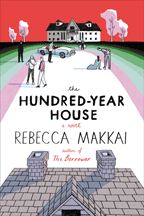Exclusive interview with author Rebecca Makkai and a review of her novel about a house haunted by one hundred years of history
Rating: 3 stars
By Gabrielle Pantera
 “I had very strange good luck as I wrote,” says The Hundred Year House author Rebecca Makkai. “There’s a ladybug infestation in the first part of the novel, and as I was reading the page proofs, a ladybug flew down and landed on the manuscript, on the word ladybug. Prior to that, when I was writing the section set in 1955, I picked an old cookbook off the shelf at the artists’ residency where I was staying, and a letter written in 1955 fell out of the book. It was all about how this woman had fired her cook, something I incorporated into the novel.”
“I had very strange good luck as I wrote,” says The Hundred Year House author Rebecca Makkai. “There’s a ladybug infestation in the first part of the novel, and as I was reading the page proofs, a ladybug flew down and landed on the manuscript, on the word ladybug. Prior to that, when I was writing the section set in 1955, I picked an old cookbook off the shelf at the artists’ residency where I was staying, and a letter written in 1955 fell out of the book. It was all about how this woman had fired her cook, something I incorporated into the novel.”
Houses are like people. They go through changes and take on the personalities of those who live in them. Makkai goes backwards in time to the beginning of Laurelfield House. Her plot twists and turns reveal the secrets of the house and those who lived there. Ghosts both real and imagined.
Laurelfield’s first owner, Violet Devohr, a Marxist English professor, is thought to have committed suicide. Then the house is turned into an artists’ colony in 1906, until later it’s turned back into a private residence. At the turn of the twenty first century, Zee, the grand daughter of Violet, moves back to Laurelfield . She and her husband Doug move into the coach house. Doug, an unemployed writer, is working on a book about one of the former residents, the poet Edwin Parffit. Can you ever really move back home, especially when it’s haunted?
Makkai began writing The Hundred Year House as a short story about two couples living together in the coach house of a large estate. “Other than that, it had nothing in common with the book I wound up writing,” says Makkai. “It took several years to see that it wasn’t meant to be a story but a novel, and longer than that to realize that the narration could, and should, move backwards through time.”
The book is set in four different years: 1999, 1955, 1929, and 1900. For the middle two in particular, Makkai had to do a lot of historical research. “I remembered 1999 well, it was the year I graduated college, and the 1900 section is very brief. Some of this research I did through immersion in the books and movies of the time, and of course the Internet is helpful for things like finding photographs of file cabinets manufactured in 1949. But I accomplished most of my research by ordering old magazines and Sears catalogs off eBay.”
This is Makkai’s second book. Her first, The Borrower, came out in 2011. She’s received awards for her short stories, particularly The Best American Short Stories.
“Several editors were interested in my first novel,” says Makkai. “So, I was able to choose someone who really got the book, but who was also willing to push me. Editing on a schedule is a challenge, as I have young children at home [4 and 6], and their plans do not always jibe with the plans of the New York publishing world.”
Nicole Aragi is Makkai’s agent. “Nicole represents quite a few of my favorite writers,” says Makkai. “Which is how I first learned of her…I had no magic ‘in’ with her though. I just sent her an email query out of nowhere. Somehow the stars aligned and her assistant passed it on to her, and things worked out.”
Makkai’s story collection, Music for Wartime, is coming out next July. She’s getting started on her next novel, which is set in the 1980s art world, against the backdrop of the AIDS epidemic.
Makkai says she loves traveling to promote her books. “Especially to places like Little Rock, Arkansas, or Manhattan, Kansas, that I’d never have known were so lovely.”
Makkai was born and still lives in Chicago.
The Hundred Year House by Rebecca Makkai. Hardcover: 352 pages, Publisher: Viking Adult (July 10, 2014), Language: English • ISBN-13: 978-0525426684 $26.95
[adrotate banner=”86″]
